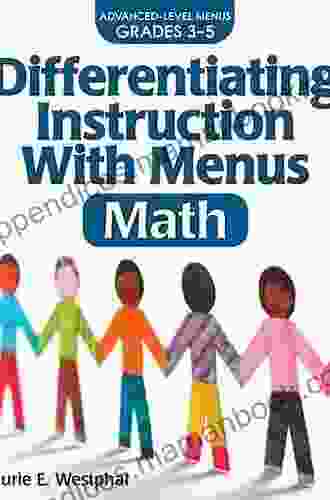Differentiating Instruction With Menus: Empowering Math Learners of All Levels

In the realm of education, the pursuit of personalized learning experiences has become paramount. Differentiated instruction, a pedagogical approach that tailors instruction to the unique needs of each student, has emerged as a powerful tool for educators seeking to engage and empower their learners.
When it comes to mathematics education, differentiated instruction can be particularly transformative. By providing students with a range of options to demonstrate their understanding and achieve learning outcomes, differentiation allows educators to cater to the diverse learning styles, interests, and abilities within their classrooms.
4.7 out of 5
| Language | : | English |
| File size | : | 16505 KB |
| Text-to-Speech | : | Enabled |
| Enhanced typesetting | : | Enabled |
| Word Wise | : | Enabled |
| Print length | : | 175 pages |
The Power of Math Menus
Math menus are a highly effective strategy for implementing differentiated instruction in math classrooms. These menus offer students a selection of activities and assignments that vary in complexity, format, and level of support. By providing choices, menus empower students to take ownership of their learning and engage with the material in a way that is most meaningful to them.
Math menus typically consist of a main course, several side dishes, and a dessert. The main course is a foundational activity that all students are expected to complete. It provides core instruction and practice on the essential concepts of the lesson.
Side dishes offer students a variety of ways to explore and practice the same concepts at different levels of difficulty. They may include games, manipulatives, problem-solving challenges, or creative projects. Students can choose the side dishes that best suit their learning needs and interests.
Dessert is an optional activity that allows students to extend their learning and demonstrate higher-level thinking skills. It may involve research projects, presentations, or complex problem-solving scenarios.
Benefits of Math Menus
Implementing math menus in the classroom offers a multitude of benefits for both students and educators.
For Students:
- Increased student engagement: By providing choices, math menus motivate students to take an active role in their learning and to pursue activities that align with their interests.
- Personalized learning experiences: Menus allow students to customize their learning path based on their individual strengths and weaknesses, ensuring that they are challenged appropriately.
- Improved problem-solving skills: Side dishes and desserts often require students to apply their knowledge in new and creative ways, honing their critical thinking and problem-solving abilities.
- Enhanced self-directed learning: Menus encourage students to make decisions about their own learning, fostering a sense of responsibility and independence.
For Educators:
- Efficient use of time: By providing a variety of activities, menus allow educators to meet the needs of all students within a single lesson, eliminating the need for repetitive instruction.
- Differentiated assessment: Menus provide multiple opportunities for students to demonstrate their understanding, allowing educators to assess student progress in a more comprehensive manner.
- Improved classroom management: By providing students with choices, menus reduce student frustration and maintain a positive learning environment.
- Increased job satisfaction: Differentiating instruction with menus allows educators to feel more effective and fulfilled in their role as facilitators of learning.
Creating Effective Math Menus
To create effective math menus, educators should consider the following best practices:
- Set clear learning goals: Identify the specific concepts and skills that students should master as a result of completing the menu.
- Offer a variety of activities: Include activities that appeal to different learning styles, interests, and levels of readiness.
- Provide scaffolding and support: Ensure that students have the necessary resources and assistance to complete the activities successfully.
- Allow for student choice: Give students the freedom to select the activities that they believe will best help them learn.
- Monitor student progress: Regularly assess student work to identify areas where additional support or differentiation may be needed.
Examples of Math Menus
Here are some examples of how math menus can be used in different math grade levels:
Elementary School:
Main Course: Solve multi-digit multiplication problems using the standard algorithm.
Side Dishes:
- Solve multiplication problems using a hundreds chart.
- Create multiplication story problems and solve them.
- Play a multiplication game, such as Multiplication Bingo.
Dessert: Research the history of multiplication and present a report to the class.
Middle School:
Main Course: Solve linear equations in one variable.
Side Dishes:
- Solve linear equations using a table of values.
- Solve linear equations using a graph.
- Write and solve real-world problems involving linear equations.
Dessert: Create a poster or presentation explaining the different methods for solving linear equations.
High School:
Main Course: Analyze and interpret statistical data.
Side Dishes:
- Create a statistical graph to represent a data set.
- Calculate the mean, median, and mode of a data set.
- Write a summary of a statistical analysis.
Dessert: Conduct an original statistical investigation and present the findings to the class.
Differentiating instruction with math menus is a powerful strategy for empowering math learners of all levels. By providing choices and tailoring instruction to the unique needs of each student, math menus create an engaging and personalized learning environment that fosters student success. As educators, we have the opportunity to unlock the potential of all our students by embracing differentiated instruction and empowering them to become confident and successful math learners.
4.7 out of 5
| Language | : | English |
| File size | : | 16505 KB |
| Text-to-Speech | : | Enabled |
| Enhanced typesetting | : | Enabled |
| Word Wise | : | Enabled |
| Print length | : | 175 pages |
Do you want to contribute by writing guest posts on this blog?
Please contact us and send us a resume of previous articles that you have written.
 Top Book
Top Book Novel
Novel Fiction
Fiction Nonfiction
Nonfiction Literature
Literature Paperback
Paperback Hardcover
Hardcover E-book
E-book Audiobook
Audiobook Bestseller
Bestseller Classic
Classic Mystery
Mystery Thriller
Thriller Romance
Romance Fantasy
Fantasy Science Fiction
Science Fiction Biography
Biography Memoir
Memoir Autobiography
Autobiography Poetry
Poetry Drama
Drama Historical Fiction
Historical Fiction Self-help
Self-help Young Adult
Young Adult Childrens Books
Childrens Books Graphic Novel
Graphic Novel Anthology
Anthology Series
Series Encyclopedia
Encyclopedia Reference
Reference Guidebook
Guidebook Textbook
Textbook Workbook
Workbook Journal
Journal Diary
Diary Manuscript
Manuscript Folio
Folio Pulp Fiction
Pulp Fiction Short Stories
Short Stories Fairy Tales
Fairy Tales Fables
Fables Mythology
Mythology Philosophy
Philosophy Religion
Religion Spirituality
Spirituality Essays
Essays Critique
Critique Commentary
Commentary Glossary
Glossary Bibliography
Bibliography Index
Index Table of Contents
Table of Contents Preface
Preface Introduction
Introduction Foreword
Foreword Afterword
Afterword Appendices
Appendices Annotations
Annotations Footnotes
Footnotes Epilogue
Epilogue Prologue
Prologue Thomas Percy
Thomas Percy Bagyalakshmi S
Bagyalakshmi S Edna St Vincent Millay
Edna St Vincent Millay Tim Rowland
Tim Rowland Joseph Pfeifer
Joseph Pfeifer D L Jackson
D L Jackson Mary Ting
Mary Ting Carrie Newcomer
Carrie Newcomer Gordon D W Curtis
Gordon D W Curtis Alison Pick
Alison Pick Lisa Gardner
Lisa Gardner Kenneth Jeffrey Marshall
Kenneth Jeffrey Marshall Lisa Ludwinski
Lisa Ludwinski Amy Oestreicher
Amy Oestreicher Robert Silverberg
Robert Silverberg Courtney Ellis
Courtney Ellis Lisa Shea
Lisa Shea Bree M Lewandowski
Bree M Lewandowski Naturally Deepak
Naturally Deepak Jan Luck
Jan Luck
Light bulbAdvertise smarter! Our strategic ad space ensures maximum exposure. Reserve your spot today!

 D'Angelo CarterInside the Private World of the White House: Unveiling the Hidden Corners and...
D'Angelo CarterInside the Private World of the White House: Unveiling the Hidden Corners and...
 Dashawn HayesThe Undereducation of an Overachiever: Unveiling the Hidden Struggles and...
Dashawn HayesThe Undereducation of an Overachiever: Unveiling the Hidden Struggles and... Jaylen MitchellFollow ·3k
Jaylen MitchellFollow ·3k Aldous HuxleyFollow ·6.9k
Aldous HuxleyFollow ·6.9k Stanley BellFollow ·19.9k
Stanley BellFollow ·19.9k Brennan BlairFollow ·10.7k
Brennan BlairFollow ·10.7k Chance FosterFollow ·9.7k
Chance FosterFollow ·9.7k Bryce FosterFollow ·6.7k
Bryce FosterFollow ·6.7k Mark MitchellFollow ·15.7k
Mark MitchellFollow ·15.7k David BaldacciFollow ·2.9k
David BaldacciFollow ·2.9k

 Jamie Blair
Jamie BlairA Delightful Blend of Love and Laughter: Exploring Short...
In the realm of literature, where imagination...

 Gary Cox
Gary CoxDetective Warren: A Gripping Tale of Suspense and...
Step into the enigmatic world of Detective...

 Junot Díaz
Junot DíazArlinlife Random Encounters: An In-Depth Exploration of...
Arlinlife Random Encounters is a...
4.7 out of 5
| Language | : | English |
| File size | : | 16505 KB |
| Text-to-Speech | : | Enabled |
| Enhanced typesetting | : | Enabled |
| Word Wise | : | Enabled |
| Print length | : | 175 pages |














